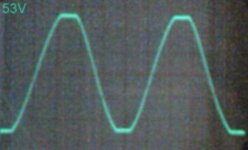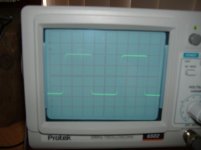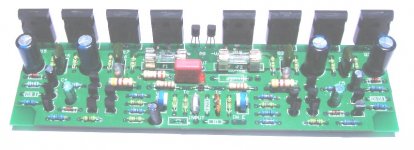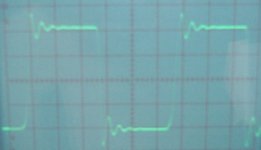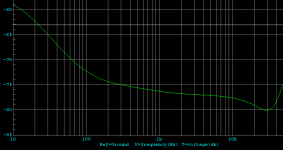Hi DJNUBZ,
Well, the answer is too cheap! I'll never get rich from these unless I sell a million ( call me), but hey I'm doing what I love!!!
See my website. Our A$ is falling away ( great management) so costs WILL rise in future.
Cheers,
Greg.
Well, the answer is too cheap! I'll never get rich from these unless I sell a million ( call me), but hey I'm doing what I love!!!
See my website. Our A$ is falling away ( great management) so costs WILL rise in future.
Cheers,
Greg.
amplifierguru said:Built up my dummy load.
And here is the amp producing 350W into 4ohms at clipping. Cleanly and without glitches of any sort.
Cheers,
Greg
What freq are you usíng?
Please provide pictures at 1kHz, 5kHz, 10kHz and 20 kHz
Thanks
\Jens
Very good, Greg... 😉 ( only little bit unsymetric SR ). Can you show me still with parallel capacity ( cca 0.1 - 1 M ) ?
thanks K-amps,
...."Forget the sound, he needs a good camera."
Yeah, well I bought the camera just need to learn how to take oscilloscope screen shots with it.
Hi Hugh and Upupa Epops,
Thanks. Actually my sig gen is a little assymetrical - need to build a better one. Any good ccts?
I took this better module picture -
Cheers,
Greg
...."Forget the sound, he needs a good camera."
Yeah, well I bought the camera just need to learn how to take oscilloscope screen shots with it.
Hi Hugh and Upupa Epops,
Thanks. Actually my sig gen is a little assymetrical - need to build a better one. Any good ccts?
I took this better module picture -
Cheers,
Greg
Attachments
Hi Greg, are you using fuses at output ? If you haven't output choke, how is square wawe by capacitive load ( at high frequency )?
> how is square wawe by capacitive load ( at high frequency )?
I would be curious about that too ! 😎
Load := 8R + 1uF
f := 10kHz
P := 100W+
Thx !
I would be curious about that too ! 😎
Load := 8R + 1uF
f := 10kHz
P := 100W+
Thx !
Hi Upupa Epops and Cortez,
I have tested the amplifier with capacitative loads and because of the extra 6 dB gain in the output x 4 (vs x 2) common source stage the amp needs the output R//L (1R1W//16T on body) for survival with capacitative loads at power.
50W 10KHz 1uF added -
Cheers,
Greg
I have tested the amplifier with capacitative loads and because of the extra 6 dB gain in the output x 4 (vs x 2) common source stage the amp needs the output R//L (1R1W//16T on body) for survival with capacitative loads at power.
50W 10KHz 1uF added -
Cheers,
Greg
Attachments
And it's now ready to go - and can deliver
300W into 8ohms using a +/-75V 300VA supply or
300W into 4ohms using a +/-55V 300VA supply!
Thanks to the high PSRR of the topology and the filtered 2BJT CCS, it doesn't need a SuperSizeMe power supply to deliver it's sonics. It doesn't need massively overbuilt power supplies to reduce intrusion of supply artefacts because this has been taken care of elegantly in the intrinsic topology.
And because it's almost R2R , there's less waste power in dissipation due to the efficient common source outputs.
Cheers,
Greg
300W into 8ohms using a +/-75V 300VA supply or
300W into 4ohms using a +/-55V 300VA supply!
Thanks to the high PSRR of the topology and the filtered 2BJT CCS, it doesn't need a SuperSizeMe power supply to deliver it's sonics. It doesn't need massively overbuilt power supplies to reduce intrusion of supply artefacts because this has been taken care of elegantly in the intrinsic topology.
And because it's almost R2R , there's less waste power in dissipation due to the efficient common source outputs.
Cheers,
Greg
I've struck a dilemma.
Despite the 'modulated bias' cascode more than halving the THD of this amplifier, I have just tried a slightly different biassing arrangement for the cascode resulting in, on sim, a 16 dB ( x6) improvement in PSRR, and in listening tests, appears to me to give a small improvement to the sound despite the 2 times higher THD of the non-modulated cascode bias.
In fact this was the original design for biassing of the cascodes before I 'discovered' the THD improvement of the modulated cascode and it is all but accomodated in the board layout requiring a small link of only 2mm and cutting one track per side.
The dilemma is - do I redesign the next run of boards to accomodate this or leave it as is? As it goes to one of the unique features of the design topology it's hard, but the default should, I suppose, be what gives the best sound but this also is subjective at this stage.
Your views?
Despite the 'modulated bias' cascode more than halving the THD of this amplifier, I have just tried a slightly different biassing arrangement for the cascode resulting in, on sim, a 16 dB ( x6) improvement in PSRR, and in listening tests, appears to me to give a small improvement to the sound despite the 2 times higher THD of the non-modulated cascode bias.
In fact this was the original design for biassing of the cascodes before I 'discovered' the THD improvement of the modulated cascode and it is all but accomodated in the board layout requiring a small link of only 2mm and cutting one track per side.
The dilemma is - do I redesign the next run of boards to accomodate this or leave it as is? As it goes to one of the unique features of the design topology it's hard, but the default should, I suppose, be what gives the best sound but this also is subjective at this stage.
Your views?
I think you should redesign to include some jumpers and some technical literature, so that choice could be made by the consumer to build it either way and decide for themselves which way sounds better. Versatility always improves a product.😀
Your THD was so low I suspect you could sacrifice quite a bit before hearing anything. How good PSRR needs to be is a function of external "insults" they you may not have total control over. Thus is doesn't suprise me that in improvemnt even in an already good PSRR figure may, in some circumstances, be audible.
Thank CBS240,
Yes choices are always nice to provide! Especially in DIY
Good point Sam,
The vagaries of DIY and how the amp might be configured and with what PS etc.. tends to favour the best PSRR path, given it has low enough to be inaudible THD.
Cheers,
Greg
Yes choices are always nice to provide! Especially in DIY
Good point Sam,
The vagaries of DIY and how the amp might be configured and with what PS etc.. tends to favour the best PSRR path, given it has low enough to be inaudible THD.
Cheers,
Greg
- Status
- Not open for further replies.
- Home
- Amplifiers
- Solid State
- 300W 'modulated bias' cascode Killer Amp
